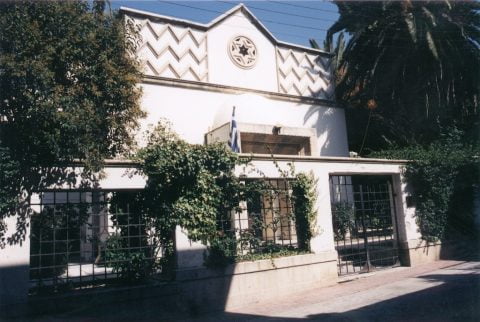A guided tour of the synagogue in Ernstein, near Strasbourg, built in 1957
A guided tour of the synagogue in Mutzig, built in 1787 and the oldest in Alsace, which is generally closed the visitors. The tour also includes the nearby church of St. Maurice.
A guided tour of the synagogue and Jewish heritage in Ingwiller.
Reservations necessary — and people must wear face masks.
There is also a tour at 14:00.
The cemetery has around 100 graves, with the oldest dating back to the 17th century.It was listed as a historic monument in 2016.


The exhibition focuses on the archaeological findings that demonstrate a Jewish presence in what is now Turkey that goes back more than 2,500 years.
The exhibit includes photos, diagrams, information panels, a 3D reconstruction, and a video that document archaeological finds including inscriptions, gravestones, and the remains of ancient synagogues.

Exhibition: Let Them Make Me a Sanctuary! Synagogues of Hungarian Communities
The exhibition introduces the sacral architecture of the Hungarian Jewry by presenting individual synagogue buildings. The authors have selected works spanning nearly a millennium in order to present the characteristics of synagogue architecture, the communities that built them and their history. After the medieval synagogues of Sopron, the baroque synagogues of Mád and the neoclassical synagogues of Óbuda, the synagogues of Pest, the jewels of romantic architecture, will also be presented. These buildings, together with the domed synagogues built at the turn of the 19th and 20th centuries (Győr, Oradea, Szeged, Subotica, Novi Sad), were important milestones in the emancipation of the Jews. The sacral buildings of the Jewish community of Kassa (Kosice), which were built to complement the Slovakian stops in the exhibition, are also shown on separate tables, and are gems of Romantic and 20th century modern architecture.
Visit only on reservation: 32 2 209 0750 / info@bmki.be
The exhibition is a joint project of the Hungarian Academy of Arts and the Hungarian Museum of Architecture and Documentation Centre for Historic Monument Protection.
Curator: dr. Ágnes Ivett Oszkó, art historian, MÉM MDK
Project Manager: Ágnes Komlóssy, Head of the International and Transnational Affairs Department of the MMA

Inauguration of the restored synagogue on the island of Kos.
A new Ark and Bimah and other interior furnishings have been installed and — after decades out of its original use — the building will be rededicated as an active house of Jewish worship.
The Kos synagogue was built in the mid-1930s to replace an older synagogue that was destroyed in an earthquake in April 1933. It was abandoned after the near-total destruction of the circa 120 member Jewish community during the Holocaust, and then was purchased by the Municipality around 1984 and used as a local cultural centre.

Presenting a selection of nearly 150 pieces from various sources, this photographic exhibition recreates the history of Salonika (today Thessaloniki) Greece from the second half of the 19th century to the end of the First World War. Men and women are captured in their traditional costumes: modest artisans, porters, traders, members of the local “aristocracy;” society is revealed. Urban modernization is also shown: the quays and the White Tower, cafes, restaurants and entertainment venues; the Countryside sector where the notables established their residence; deprived areas, where emerging industries were established.
But also, in the now Greek city, the great fire of August 1917, an authentic trauma for the Jews who saw their historic neighborhoods, the municipal archives and more than thirty synagogues swept away by the flames, before the geopolitical upheavals caused by the First War worldwide.


Comments are closed.